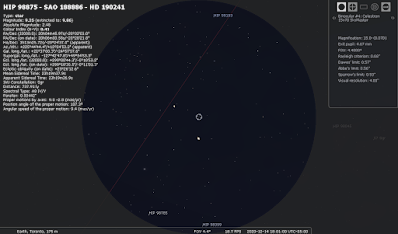First, the view in binoculars, jumping one week at a time. I configured the software to use 15x70 binoculars which yield a 4½ degree field. Of course, up is up and east is left.
A week later. You can see tree-tops in this snap. Elevation 6°. Separation: almost 1°; some 50 arc-minutes.
Then in a telescope. I configured the software for an 8-inch Schmidt Cassegrain Telescope with a 26mm eyepiece with produces a magnification of 77x and a field of view diameter of about 3/4 of a degree, 40 arc-minutes to be precise. Also set as in an equatorial mount. This is a mirror-reversed or laterally-inverted view. Therefore north is up and east is right.
Dec 20, above. Separation: 8½ arc-minutes.
Dec 21. Closest approach. Separation: 6¼".
And then Dec 22. Separation: 10".
You can see the moons dancing about. I did not include the labels to keep the screen uncluttered... You'll want to use some software to identify all them.
Finally, I simulated the view with a 9mm and a doubler on Dec 21. Wow.
Let's hope for clear skies. This will be amazing.
§
The YouTube video I made on Nov 14 shows the scene wide-field, say with just your eyes.
§
Added a post addressing airmass, the amount of air you're looking through when celestial objects are low near the horizon...











No comments:
Post a Comment